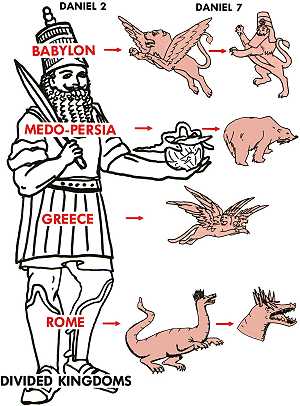
The Antichrist
Trinity
Soul
Heaven
Hell
Satan/Demons
"Saved"
Baptism
Resurrection
Antichrist
History
Mistaken ID
Great Delusion
Chapter 1
Chapter 2
Chapter 3
Chapter 4
Chapter 5
Chapter 6
Chapter 7
Chapter 8
Chapter 9
Chapter 10
Chapter 11
Chapter 12
Chapter 13
Chapter 14
Chapter 15
Chapter 16
Chapter 17
Chapter 18
Chapter 19
Chapter 20
Chapter 21
Chapter 22
Unique
Catholic
Mormon
SDA
JW
British Israel
Church
of Christ
Pentecostal
Islam
Science
Miracles
Evolution
Creation
Carbon Dating
Inspiration
Partial
Contradictions
& Inaccuracies
Chapter 9
Daniel 7 - The Prophecy of Four Beasts
A few years later, Daniel was shown another vision (Daniel 7:1-8) about four great beasts arising out of the sea. In verses 17-18 we are given the explanation that these four beasts are four kings or kingdoms that would arise out of the earth, and after them, the saints of the Most High will receive and possess the kingdom for ever. Certainly there is a relationship between the four parts of Nebuchadnezzar's image in Daniel 2 (which indicated the four world empires that would arise before God's Kingdom) and these four beasts in chapter 7.
In Daniel 7 we read of four great beasts arising out of the sea. The first beast was like a lion (v.4) and it corresponds to the head of Nebuchadnezzar's image, representing the Babylonian Empire.  The next beast was like a bear and it related to the breast and arms of the image (the Medo-Persian Empire). The third beast was like a leopard (v.6), which corresponds to the belly and thighs of the image (the Grecian Empire). Next we read of a fourth beast (vs.7-8) which relates to the two legs of the image (the Roman Empire). This last beast was "terrible and dreadful and exceedingly strong" indicating the great power of the Roman Empire, and it had "ten horns" showing that it would eventually be divided between ten kings or nations.1 As Daniel watched, three of the horns (the Vandals, Lombards, and Huns) were plucked up by the roots or destroyed when another little horn (the Holy Roman Empire) came up among them. This little horn had eyes and a mouth, and spoke great things (vs.19-20).
The next beast was like a bear and it related to the breast and arms of the image (the Medo-Persian Empire). The third beast was like a leopard (v.6), which corresponds to the belly and thighs of the image (the Grecian Empire). Next we read of a fourth beast (vs.7-8) which relates to the two legs of the image (the Roman Empire). This last beast was "terrible and dreadful and exceedingly strong" indicating the great power of the Roman Empire, and it had "ten horns" showing that it would eventually be divided between ten kings or nations.1 As Daniel watched, three of the horns (the Vandals, Lombards, and Huns) were plucked up by the roots or destroyed when another little horn (the Holy Roman Empire) came up among them. This little horn had eyes and a mouth, and spoke great things (vs.19-20).
Since Daniel wanted to know more about this fourth beast, he was told in verses 19-27 that the beast would have teeth of iron and claws of bronze, indicating the large geographical area this beast would powerfully dominate. In Nebuchadnezzar's image iron was linked to the Roman Empire and bronze to the Grecian Empire. Thus this fourth beast would incorporate the authority and dominion of both empires.
Daniel was also told that the little horn on this beast will speak words against the Most High and it will make war on the saints and prevail over them for a "time, two times and half a time" (v.25) or 1260 years.2 After this period, the "Ancient of Days'' will come and the saints will receive the kingdom. Thus this prophecy indicated that a great power would arise out of the Roman dominion that would blaspheme God and persecute the saints for many years.
Up to this point then, we have found that Daniel 2 clearly indicates the four world empires that would arise, and Daniel 7 refers to these empires again, giving us more detail especially of the fourth empire (the Roman Empire). These two chapters of Daniel form the backbone for interpreting many of the prophecies in the Bible, and for this reason we have considered them first. The remaining prophecies will be studied on the basis of these clear prophecies in Daniel.
| BACK |
Footnotes:
1. The ten nations are: 1) Huns, 2) Vandals, 3) Visigoths, 4) Burgundians, 5) Gepidoe, 6) Lombards, 7) Franks, 8) Suevi, 9) Alans, 10) Bavarians. These nations became the rulers of the divided Roman dominion when the empire fell during the 5th century.